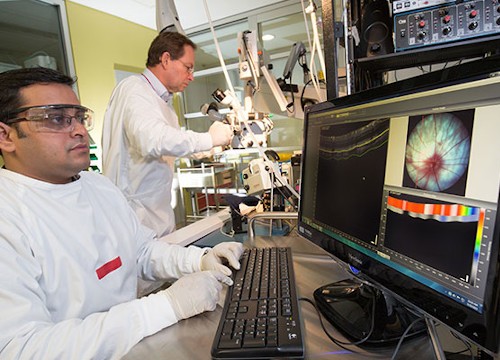Industry News
Macquarie Medical School Researchers Discover Gene Therapy for Glaucoma Treatment
 Macquarie Medical School scientists have made a groundbreaking development in the field of gene therapy that could revolutionise the treatment of glaucoma, the world's leading cause of irreversible blindness. Their technique aims to ensure the continuous production of a crucial protein in nerve cells, which protects them from degradation and, in turn, prevents the progression of the disease.
Macquarie Medical School scientists have made a groundbreaking development in the field of gene therapy that could revolutionise the treatment of glaucoma, the world's leading cause of irreversible blindness. Their technique aims to ensure the continuous production of a crucial protein in nerve cells, which protects them from degradation and, in turn, prevents the progression of the disease.
Glaucoma affects over 70 million people worldwide, including approximately 300,000 Australians. The disease is characterized by gradual vision loss, initially in the peripheral areas and later spreading centrally. It primarily damages the optic nerve and the retinal ganglion cells, responsible for transmitting visual information to the brain.
Typically, glaucoma is associated with increased pressure in the eye, and it can be detected through routine vision tests that measure eye pressure or inspect the optic nerve using specialized scanners.
While the damage caused by glaucoma is irreversible, the progression of the disease can often be slowed or halted through pressure-lowering treatments. However, some patients continue to experience deterioration despite these interventions, suggesting the involvement of other factors beyond pressure.
Led by Professor Stuart Graham, an Ophthalmology expert at Macquarie Medical School, a team of researchers is exploring the role of the protein neuroserpin in glaucoma. Vision neurobiologist Associate Professor Vivek Gupta states that their findings indicate neuroserpin's vital role in protecting retinal ganglion cells. Although previous studies have associated changes in neuroserpin with conditions like stroke, Alzheimer's, and Parkinson's diseases, this is the first research to link it to glaucoma.
In the absence of neuroserpin, the natural breakdown and recycling process of cells in the body accelerates in the retina. Consequently, the body begins to degrade the retinal ganglion cells and the optic nerve, leading to vision loss.
The team's research also reveals that when neuroserpin oxidizes, it loses its protective ability, resulting in accelerated cell breakdown. In contrast, their studies on mice demonstrate that increased production of neuroserpin promotes the survival of retinal ganglion cells and minimizes glaucoma damage.
Dr. Nitin Chitranshi, a vision scientist at Macquarie Medical School, explains that their latest work, published in the latest edition of Molecular Therapy, involves manipulating a gene in mice to produce a version of neuroserpin resistant to oxidation. By introducing this gene directly into the eye, they observed increased neuroserpin production in the retina. They are also developing a method to specifically target the retinal ganglion cells for neuroserpin production, excluding other neurons.
The team is now preparing for further testing of the enhanced gene and will commence new trials shortly.
Professor Graham emphasizes that glaucoma is a complex disorder involving multiple mechanisms that are not yet fully understood. While their gene therapy approach may not be a universal solution, it has the potential to complement existing therapies and enhance the resistance of nerve cells to damage.
Although more work remains before translating these findings into human studies. The team's research was supported by a National Health and Medical Research Council Ideas Grant.



